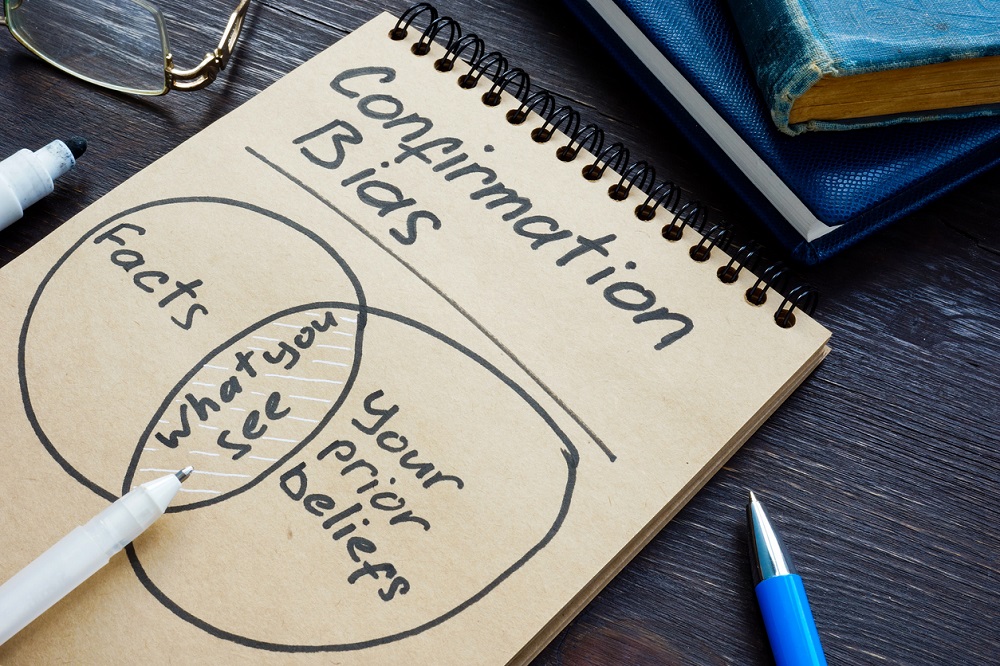Which coaches, managers and leaders are at risk of confirmation bias? Basically, all of us. Confirmation bias is horribly easy to fall into. It can cloud anyone’s judgement. And it’s wise to know about it so you can keep your thinking clear. Here’s what you need to know.

What is confirmation bias?
Wikipedia defines confirmation bias as ‘the tendency to search for, interpret, favour, and recall information in a way that confirms or supports one’s prior beliefs or values.’ If we believe the moon is made of cheese or the world is flat, we’ll naturally seek out information that confirms our beliefs – while ignoring information that casts doubt on our convictions. And we rarely realise what we’re doing.
We skew our views in this way because it feels good to be agreed with, to be right, to be justified, to be reassured, and because it’s good to know other people feel the same way as we do. The danger is, confirmation bias makes us less likely to question our beliefs, which means we can easily fall into traps. Fake news is an excellent example. If the news falls in line with what we believe, it’s surprisingly hard to reject it. We naturally share information that we like to think is true.
Because it takes a lot of time and energy to process all the facts, we tend to focus on information that dovetails best with pre-existing opinions and knowledge. This type of intellectual shortcut is called heuristics. We accept agreeable information as accurate and true. We overlook inconsistencies and inaccuracies. We add it to our belief system, and we use it to support our beliefs in future. On the other hand if information doesn’t chime with our expectations we get defensive and critical, ignore the information, and quickly forget it.
As you can imagine, confirmation bias isn’t the best way forward in business. To succeed in the long term we need to focus on actual reality, not our own versions of it.
Can confirmation bias be changed?
It sounds negative, but there’s a positive side to all this. The thing about our confirmation bias beliefs is, they feel personally real but they are not set in stone. Sometimes they are accurate and grounded but other times they do not paint the whole picture. Beliefs are also often emotionally charged but they can be questioned and changed if we are open to doing so. Rattling our confirmation bias ideas shakes out whether our interpretations are true or not.
Yours might be sound or they could be holding you back in some way, since beliefs are merely stories that we tell ourselves. Identifying a confirmation bias gives us the ability to change our perception of our own subjective reality if needs be, and therefore how we act within it. And that means we can intentionally redirect our focus, finding evidence to support new, positive beliefs that replace unhelpful, limiting and negative beliefs.
About the three 3 types of bias
There are three pitfalls to think about. There’s the biased search for information, the biased interpretation of that information, and the biased recall of the information.
A biased search for information means you only seek out positive evidence that supports your expectations, ignoring any evidence that could prove you wrong. Biased interpretation, also called selective interpretation, involves taking your own biased view of the information while avoiding the idea that it could be interpreted very differently by someone else. And biased recall means we only remember the things we agree with, handily forgetting information that dents our beliefs.
Confirmation bias in the workplace
Confirmation bias trips us up because it feels so right. It chimes with our inner selves, strengthens our world view, and makes us feel more in control, all of which is very hard to resist when the alternative is so uncomfortable.
Take diversity and inclusion issues. If you have a biased view of a certain type of person, or race, or creed, and you spend your time seeking out information that strengthens your bias and avoiding anything that threatens it, where do you end up? With a workforce that isn’t balanced or open to new people, ideas and innovative solutions.
Overconfidence is another danger, where you’re convinced you’re right despite everything. This over-confidence can leave you closed to new things, missing out on different ideas and fresh perspectives.
Here’s an example. The boss has a bright idea for a new product. The team is told to research the idea to make sure it’s feasible. The resulting surveys, focus groups, and analysis are already biased by the boss’s personal convictions and the data isn’t allowed to speak. The team begins the product development process knowing what’s required by the boss. The questions they ask are likely to be biased too, so the boss gets the answers they want to hear. Ultimately the product fails.
How do you know you’re suffering from confirmation bias?
So how can we develop a better awareness of when and how confirmation bias affects our decision-making, or damages our openness to new things? And what strategies can we use to mitigate it?
First, keep an eye open for the signs of confirmation bias. Because they can be extremely subtle, it’s an exercise in heightened self-awareness involving some tough questions. Are you only looking for information that confirms your beliefs while discrediting anything that doesn’t? Are you only looking for the evidence to confirm your own truth instead of examining everything available? Are you relying on stereotypes or personal biases? Do you selectively remember what makes you feel good and discount the things that rattle you? And do you have a powerful emotional reaction when your beliefs are confirmed but remain unaffected by information that doesn’t confirm your biases?
How to overcome your own confirmation bias
The first step to avoiding confirmation bias is to be aware it’s an issue. Once you understand what’s going on it’s easier to spot, so this article should be a useful starting point.
It’s interesting to note that biases are most likely to happen early in the decision making process. So make sure you begin with a neutral standpoint. It might be useful to ask a group of people to gather facts so there’s a varied and objective range of evidence to work with.
Listen to your instincts. If you’ve experienced a strong physical reaction to a request you don’t like, ask yourself why. Is it reasonable to feel that way or is it just instinctive biases coming to the fore? You might find it helpful to talk to a wide range of other people to pin down any individual biases in the evaluation process.
When gathering data make sure you ask neutral questions, not pre-loaded with bias. The data you get depends on the questions you ask, and the questions depend on what you want to get out of the exercise, so take care. Ask objective third-parties to check for bias. And make it a habit to play devil’s advocate.
In conclusion…
While you might not be able to completely get rid of it, simply being aware of confirmation bias and the difficulties humans have in overcoming it goes a long way to help avoid poor business decisions.
The more people at work who understand what it means and how it can affect them, the more likely they are to be able to defuse it. The more awareness people have about the traps of confirmation bias and recognising the signs, the easier it will be to remain open, to value differing perspectives and learn from each other. And any business will be nourished by those qualities at the heart of its culture.
About us:
We create the space for leaders to step back, think clearly, and navigate complexity with confidence. By sharpening the narrative that drives decisions, teams, and performance, we help leaders move forward with clarity and impact. Our approach blends deep listening, incisive challenge, and commercial focus—strengthening leadership at every level, from business transformation to boardroom decisions.
“We share resources that help coaches deepen their practice and expand their impact. The articles on this site are designed to spark fresh thinking, offer practical tools, and support the continuous growth of coaches at every stage. “
Jude Elliman
Founder
Our Core Approach:
We work with leaders to sharpen their thinking, strengthen their leadership, and navigate complexity with confidence. Our approach is built around three core areas:
Narrative Coaching – Working with the stories that shape leadership, teams, and organisations.
Commercial Focus – Cutting through complexity to drive clear, strategic decisions.
Challenge & Space – Asking the right questions while creating the space to reflect and grow.
Through this, we help leaders drive transformation, align teams, and make high-stakes decisions with clarity and impact.


